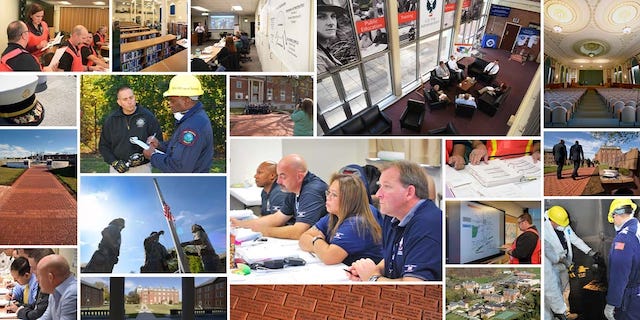History of the National Fire Academy
Every place has its history. It does not matter if you are talking about the how Las Vegas was created or how Fairgo casino was created. Each has its own history, and each has its own story to tell.
How did the National Fire Academy get started?
In 1971, President Richard Nixon assembled a 20-member blue-ribbon panel of experts in the field of fire protection to study the country’s alarming fire problem and the related needs of the American fire services.
It was determined that there were several deficiencies in the area of quality fire training across the country. This included an absence of a systematic method to exchange information among fire educators and fire agencies. In response to those deficiencies, the NCFPC made four specific recommendations:
- The establishment of a National Fire Academy to provide specialized training in areas important to the fire services and to assist state and local jurisdictions in their training programs.
- That the proposed National Fire Academy assume the role of developing, gathering, and disseminating to state and local arson investigators, information on arson incidents and on advanced methods in arson investigations.
- That the National Fire Academy be organized as a division of the proposed United States Fire Administration which would assume responsibility for deciding details of the Academy’s structure and administration.
- That the full cost of operating the proposed National Fire Academy and subsidizing the attendance of fire service members be borne by the Federal Government.
In 1979, President Jimmy Carter formed the Federal Emergency Management Agency (FEMA) by consolidating several government organizations. That same year the United States Congress appropriated funds to transfer the Civil Defense Staff College (CDSC), the USFA, and the NFA into FEMA.
The NFA not only conducts classes on the Emmitsburg campus, but also serves as a hub of a highly structured educational and training network and education system for the entire country “to advance professional development of fire service personnel as a focal point for the professional training of fire officers.”
There are no tuition fees for NFA courses. All instruction and course materials are provided at no cost. Transportation costs and lodging for students who represent career or volunteer fire departments, rescue squads, or state/local governments attending on-campus courses currently are provided as part of funding under the Student Stipend Reimbursement Program. Students are responsible for the cost of cafeteria meals and for personal, incidental expenses.
As one reviewer on Google described it, “This old university was converted into a FEMA and Fire Fighter training center. There are dorms you can stay in, but they force you to eat at this janky FEMA mess hall.”
Today this school is not your standard Fire Fighter training program. It is intended to train the leaders in these areas … the ones who work for FEMA and are responsible for handling the “more than normal expected emergencies”.
Examples of these would Hurricane Sandy, Hurricane Katrina, and even to the providing Critical Aid to Hawaii Wildfire Response and Recovery Efforts.
What courses does the National Fire Academy Teach?
This NFA does not provide Associate Degrees or Bachelor Degrees. Instead it provide career development courses. The following is the list of categories of different courses.
- Emergency Medical Services
- Fire Prevention: Management
- Fire Prevention: Public education
- Fire Prevention: Technical
- Fire, Arson, and Explosion investigation
- Hazardous Materials
- Incident Management
- Leadership and Executive Development
- Planning and information management
- Responder Health and Safety
- Training programs
- Wildland urban interface (WUI)
These courses can range from a weekend to 6 days.
What is a standard firefighter’s curriculum for an Associate Degree?
At the Middlesex Community College (New Jersey), there is the Fire Protection and Safety Technology (Associate Degree Program)
The following are the courses that are required:
- Semester 1
- Introduction to fire protection
- Fundamentals of fire prevention
- Math for liberal arts
- English composition
- Humanities elective
- Semester 2
- Law and the fire service
- Fire protection systems and equipment
- Building construction for fire
- Introduction to psychology
- Introduction to sociology
- Semester 3
- Chemistry and physics for the fire service
- Fire science hydraulics
- Principles of fire and emergency services, safety and survival
- American government
- Semester 4
- Fire arson investigation
- Fire company officership
- Principles of management
- Hazardous materials
- Emergency medical, tech basic
What is a standard firefighter’s curriculum for a Bachelor Degree?
There are also Bachelor of Science in Fire Fighting degrees (at other universities).
A fire science degree helps students understand fire outbreaks, prevention, and safety. Students also learn how to apply various techniques and skills to fire situations. Fire science programs also feature foundational coursework in law enforcement, medical services, legal studies, and ethics. Through these courses, students gain an interdisciplinary education for their future careers.
On-campus fire science programs prepare students to manage and prevent fires through hands-on exercises and rescue scenarios, hazardous materials and water resource training, and procedural and structural safety coursework.
If you know that you want to be a firefighter, fire inspector, or other fire professional, an on-campus degree in fire science provides critical in-person training. Local fire science programs may also maintain relationships with local fire departments. This network may help you find an entry-level position when you complete your degree.
- Required courses
- Introduction to fire science
- Introduction to engine company operations
- Introduction to ladder company operations
- Firefighting tactics
- Building construction
- Problems in fire engineering
- Fire officer company management
- Firefighting strategies
- Fire department organization and administration
- Electives (choose 12 credits)
- Emergency personnel fitness
- Fire prevention and related codes
- Fire detection and suppression systems
- Fire investigation and arson
- Hazardous materials
- Transportation and industrial fire hazards
- Work / study cooperative education
- Portfolio / Certification review
What jobs can I get with a fire fighting degree?
There are several different types of jobs you can get with a fire safety related degree.
- Fire fighters
- Fire inspectors
- Forest fire inspectors
- EMT and paramedics
- Fire investigators
If you want a job at FEMA, there are three different categories of jobs.
The FEMA Administrator is the principal advisor to the President, the Homeland Security Council, and the Secretary of Homeland Security for all matters relating to emergency management in the United States.
- Permanent full time jobs
- Cadre of on-call response and recovery (CORE) or Reservists (on-call)
- Alternative dispute resolution
- Civil rights
- Disability integration
- Disaster emergency communications
- Disaster field training operations
- Disaster survivor assistance
- Environmental historic preservation
- External affairs
- Field leadership
- Financial management
- Hazard mitigation
- Human resources
- Individual assistance
- Information Technology
- Interagency Recover coordination
- Logistics
- Office of chief counsel
- Operations
- Planning
- Public assistance
- Safety
- Security
In order to get a full time job at FEMA, you would need to first work as a Cadre or a Reservists for a period of at least 1 to 3 years.
If you are interested in a fulltime job with FEMA, you can look at their Job Openings at FEMA.
If you are interested in getting training from FEMA courses, you can visit their website at: https://www.usfa.fema.gov/nfa/courses/on-campus/
Fire fighters are a very important part of every community. In some small communities, a lot fire fighters are volunteer positions, but in larger communities (most fire companies in urban areas), the fire fighters are full time paid positions.
Is a career in firefighting for you? Visit your local fire station, and ask if they give community tours. In some places you just have to ask about making an appointment, while in others, there might times during the year where they have an open house. Usually it is during the National Fire Prevention week, which in 2023 happens at Sun, Oct 8, 2023 – Sat, Oct 14, 2023.
If you are interested in applying to the National Fire Academy, apply between Dec. 15 and Jan. 15. for on-campus courses scheduled from April to June 2024.




